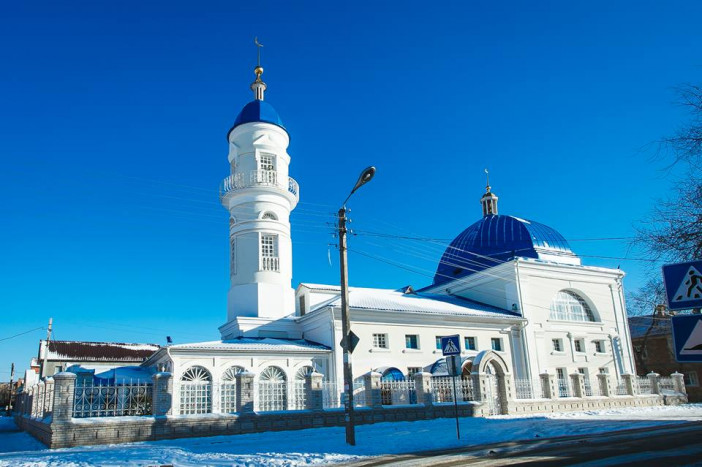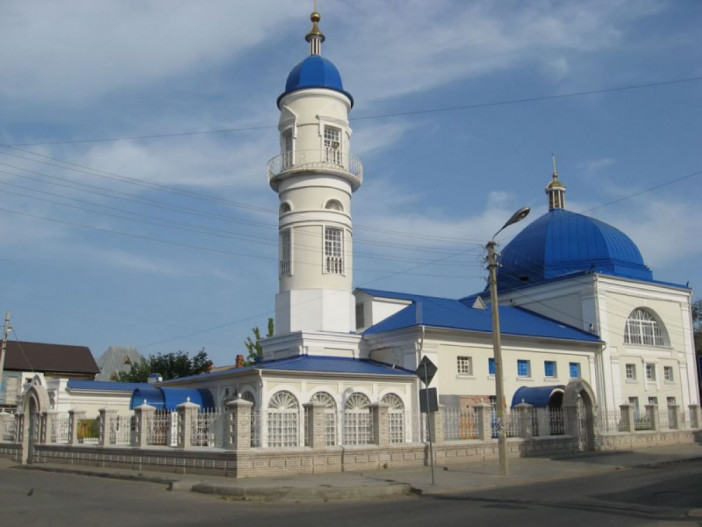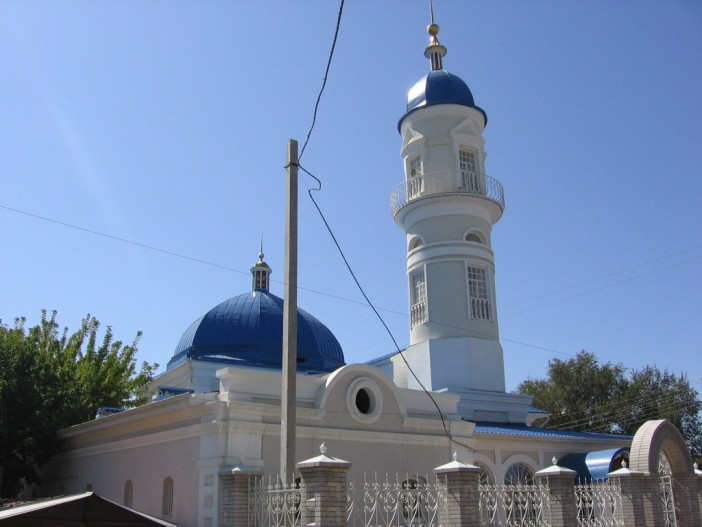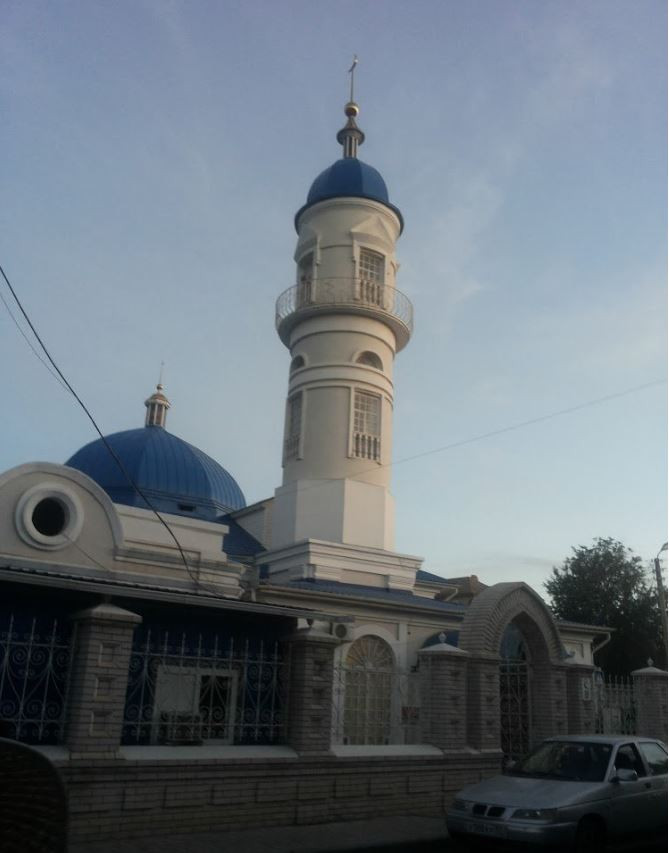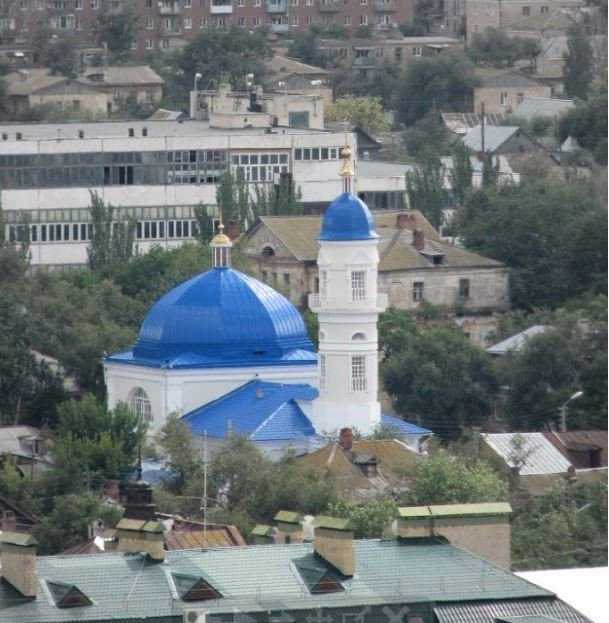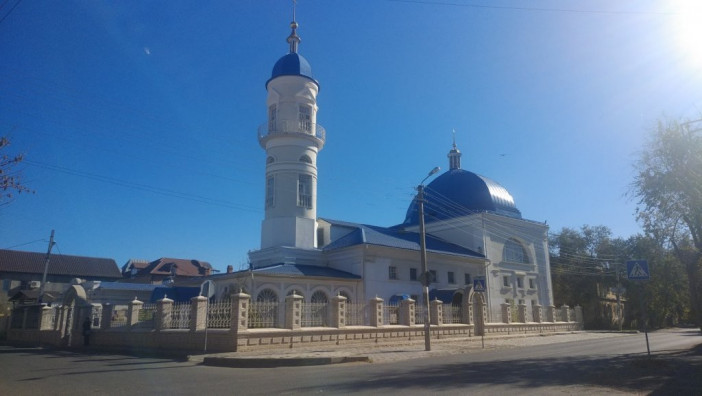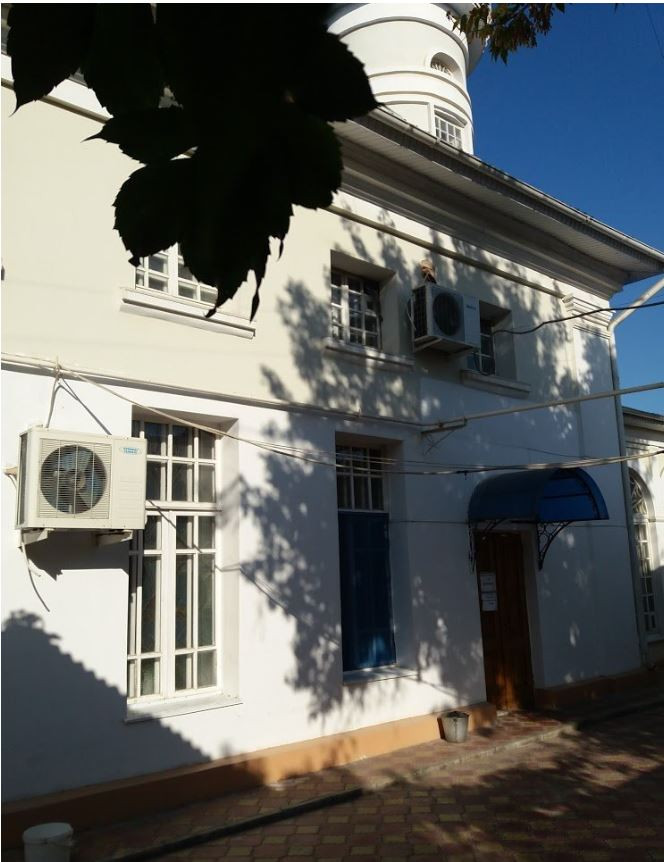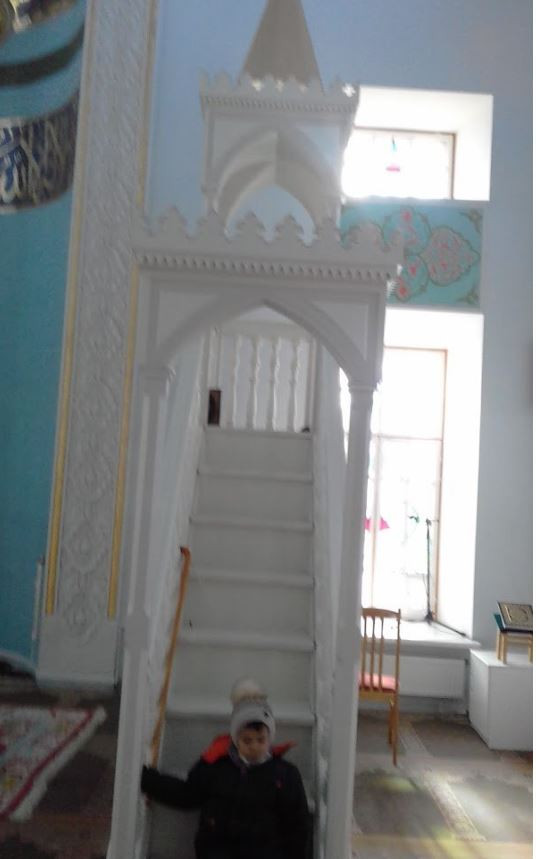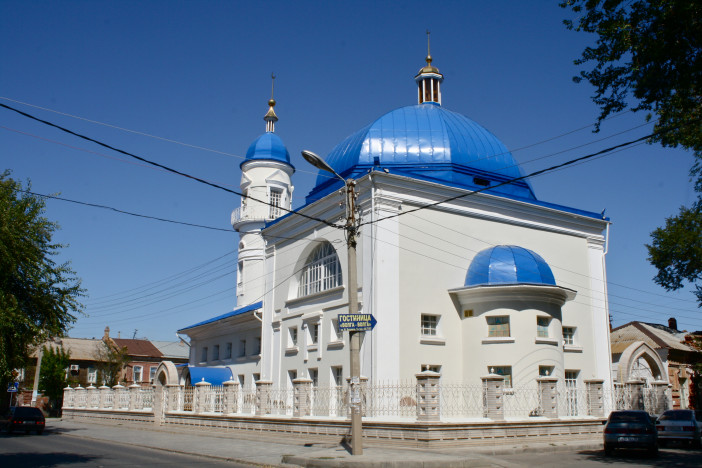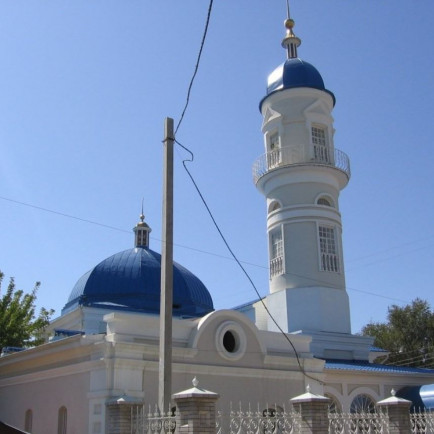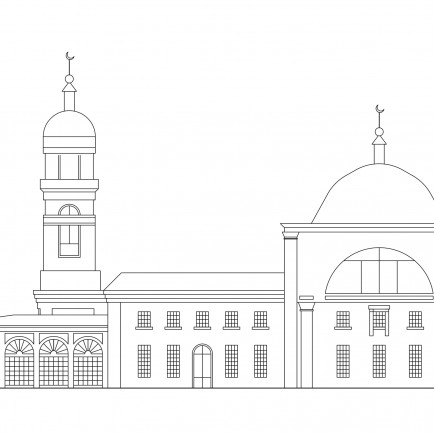White Mosque
History
The first mention of this mosque is contained in the work of Academician S.G. Gmelin "Journey through Russia to explore the three kingdoms of nature", published in St. Petersburg in 1777. He wrote that in the Bukhara Tatar court of Astrakhan "there is a newly built large Tatar mosque. It is wooden, but built on a stone foundation. It is assumed that in this case we are talking about the White Mosque, which was located in the Bukhara Tatar settlement.
In 1810, on the site of the one that had existed since the beginning of the 18th century. wooden mosque, in the 2nd part of the city of Astrakhan in the so-called Tatar settlement, behind the canal, on the territory of the Bukhara courtyard, the first stone mosque in the city was built.
Like the former wooden one on this site, the new stone mosque was called Belaya (Ak-mosque). The mosque bears this name to this day. It was the White Mosque that gave rise to the architectural type of Astrakhan stone mosques, as the earliest stone religious Muslim building in the city.
The explanation of the historical name "White" is given in his work by the researcher-geographer and traveler I.V. Rovinsky. He wrote that this was the main Tatar mosque in the city, since it was “the most spacious and best made”, and besides, “... among the Tatars, the main mosques are always called white.”
The mosque was built at the intersection of three streets, which in the subsequent history of the Astrakhan mahalla became the center of its social activity: Belomechetnaya (named in fact, in honor of the mosque, it began from it; it was very prestigious to live on this street, the richest Tatars built houses here city), 2nd Mechetnaya and Admiralteyskaya. Now this is the intersection of Z. Kosmodemyanskaya, Bera and Kazanskaya streets.
Urban and Architectural
The mosque, built of red brick, is made in the architectural forms of late classicism. The decoration was extremely stingy and restrained. Its volumetric and planning solution, as well as the proportional ratios of individual parts of the composition, are reminiscent of a parish Orthodox church. On the top of the walls of the two-part prayer hall, the lower quadrangle and the mihrab, there was a profiled cornice of insignificant extension, which rested on wide shoulder blades located at the corners of the volumes. The eastern and western facades of the southern half of the prayer hall were additionally divided into two tiers by a profiled cornice, which supported small blades on both sides. The openings of the lower part of the wall, arranged in one line with the openings of the northern half of the prayer hall, were located in two tiers. The middle windows of the upper tier were framed with architraves with a profiled cornice at the end. In the upper half of the wall there was one large semicircular opening, framed by an archivolt with a keystone at the top. An elongated rectangular niche is placed under the opening. Two small niches are also arranged above the capitals of small blades.
From the south, the building of the mosque was limited by the Second Mechetnaya Street, from the north - Belomechetnaya, and from the west - Admiralteyskaya. From the east it adjoined the neighboring property. The building of the mosque was not placed along the red line of the street, but was shifted to the back of the courtyard. Oriented strictly to the south, it was not built strictly parallel to Admiralteyskaya Street, but was located at a slight angle to it.
In 1810, the mosque was a rectangle stretched from south to north measuring 12.5 by 5 fathoms. From the south, a semicircular ledge of the mihrab adjoined it, and from the north, a rectangular ledge of the minaret, equal in main dimensions to the southern one. The walls of the mosque were built of red brick measuring 25.5x12.5x6 cm with lime mortar and pile masonry. Outside and inside they were plastered.
As can be seen in the pre-revolutionary photographs that have survived to our time, the mosque consisted of a prayer hall (strongly elongated from south to north. Size 11x22.5 m), to which a semicircular ledge of the mihrab adjoined from the south, and from the north a minaret with arched galleries surrounding it. The one-story prayer hall had a two-part structure, it consisted of two volumes: a young high three-height one under a flat faceted dome and a lower two-height one under a gable hip roof. Inside, both rooms, which had flat wooden ceilings, were separated by a stone wall with three arched ceilings arranged in it: the middle one and two side ones. Along the perimeter of the walls of the northern premises there were mezzanine galleries for women. From the gallery, through the entrance located above the main doorway, one could get into the minaret and climb the internal stairs to the upper platform. The southern volume was a rectangle elongated from east to west with sides of 11x13.5 meters. Its height reached 16 meters. Window openings were arranged in three tiers. It had a gently sloping octahedral dome-shaped cover placed on a low wooden octahedral drum. The covering ended with a thin octagonal drum with a ball and a crescent above it. The second one adjoined the southern volume from the north. In plan, it was a rectangle, elongated from north to south. In width, it was only slightly inferior to the first , and in length significantly exceeded it. Its dimensions in plan were 13x14 meters. The northern volume was double-height, it was significantly inferior in height to the first one, its height was 8 meters. It was covered with a gable hip roof. From the south, a semicircular ledge of the mihrab adjoined the prayer hall. It was illuminated by two-tiered window openings. It was equal in height to the northern half of the prayer hall and had a metal covering in the shape of a conch. A minaret adjoined the prayer hall from the north. Before the revolution, it consisted of a lower quadrangle in plan, equal in height to the northern half of the prayer hall. The width of the minaret was equal to the width of the mihrab and was 4 meters. Later, the lower quadrangle of the minaret was surrounded by arched galleries. Their width was equal to the width of the prayer hall, while their height was significantly inferior to them and amounted to 4 meters. Above the lower quadrangle of the minaret was its upper cylindrical part. Its diameter was only slightly inferior to the width of the lower quadrangle. The height of the upper quadrangle exceeded the lower one and a half times. The cylinder was illuminated by two-tiered window openings. There were exits from the platform of the upper tier of the minaret and a round balcony surrounding the cylinder, the existence of which did not last long. The minaret was covered with a dome with a thin octagonal drum at the end. Topped with a ball with a crescent above it. The windows of the upper minaret had the richest architectural frame. In the lower tier, they were made up of two parts: the lower one, elongated in height, rectangular and the upper semicircular, united by a ribbon casing. The openings of the upper tier were framed with architraves "with ears" and a triangular pediment at the end. Unlike the windows of the minaret, the openings of the first and second tiers of the prayer hall were devoid of frames. The windows of the lower tier were shallow in proportions elongated in height, their height being two and a half times their width. Rectangular openings had a wooden lintel with a brick wedge-shaped one laid on it. Above the western doorway there is a rectangular niche, located on the same line with the windows.
Description
There were three entrances to the mosque. The main one, the northern one, was arranged in the lower quadrangle of the minaret and the second one, the western one, was located in the center of the facade of the northern half of the prayer hall.
Already in 1870, the White Mosque was considered a historical landmark. "Astrakhan provincial sheets" wrote: "The Tatar mosque was built in 1810 instead of a wooden one that existed on this site for 130 years."
References
https://islam-astrakhan.ru/categories/glavnye-stati-s-glavnoj/belaya-mechet
https://russia-islworld.ru/kultura//the-six-oldest-russian-mosques-2021-03-23-15452/
https://topgid.net/4874-sobornaja-belaja-mechet.html
Details
Location
Kazanskaya Ulitsa, 34, Astrakhan, Astrakhan Oblast, russia، 414000
Year of Build
1777
Drawings
Map
History
The first mention of this mosque is contained in the work of Academician S.G. Gmelin "Journey through Russia to explore the three kingdoms of nature", published in St. Petersburg in 1777. He wrote that in the Bukhara Tatar court of Astrakhan "there is a newly built large Tatar mosque. It is wooden, but built on a stone foundation. It is assumed that in this case we are talking about the White Mosque, which was located in the Bukhara Tatar settlement.
In 1810, on the site of the one that had existed since the beginning of the 18th century. wooden mosque, in the 2nd part of the city of Astrakhan in the so-called Tatar settlement, behind the canal, on the territory of the Bukhara courtyard, the first stone mosque in the city was built.
Like the former wooden one on this site, the new stone mosque was called Belaya (Ak-mosque). The mosque bears this name to this day. It was the White Mosque that gave rise to the architectural type of Astrakhan stone mosques, as the earliest stone religious Muslim building in the city.
The explanation of the historical name "White" is given in his work by the researcher-geographer and traveler I.V. Rovinsky. He wrote that this was the main Tatar mosque in the city, since it was “the most spacious and best made”, and besides, “... among the Tatars, the main mosques are always called white.”
The mosque was built at the intersection of three streets, which in the subsequent history of the Astrakhan mahalla became the center of its social activity: Belomechetnaya (named in fact, in honor of the mosque, it began from it; it was very prestigious to live on this street, the richest Tatars built houses here city), 2nd Mechetnaya and Admiralteyskaya. Now this is the intersection of Z. Kosmodemyanskaya, Bera and Kazanskaya streets.
Urban and Architectural
The mosque, built of red brick, is made in the architectural forms of late classicism. The decoration was extremely stingy and restrained. Its volumetric and planning solution, as well as the proportional ratios of individual parts of the composition, are reminiscent of a parish Orthodox church. On the top of the walls of the two-part prayer hall, the lower quadrangle and the mihrab, there was a profiled cornice of insignificant extension, which rested on wide shoulder blades located at the corners of the volumes. The eastern and western facades of the southern half of the prayer hall were additionally divided into two tiers by a profiled cornice, which supported small blades on both sides. The openings of the lower part of the wall, arranged in one line with the openings of the northern half of the prayer hall, were located in two tiers. The middle windows of the upper tier were framed with architraves with a profiled cornice at the end. In the upper half of the wall there was one large semicircular opening, framed by an archivolt with a keystone at the top. An elongated rectangular niche is placed under the opening. Two small niches are also arranged above the capitals of small blades.
From the south, the building of the mosque was limited by the Second Mechetnaya Street, from the north - Belomechetnaya, and from the west - Admiralteyskaya. From the east it adjoined the neighboring property. The building of the mosque was not placed along the red line of the street, but was shifted to the back of the courtyard. Oriented strictly to the south, it was not built strictly parallel to Admiralteyskaya Street, but was located at a slight angle to it.
In 1810, the mosque was a rectangle stretched from south to north measuring 12.5 by 5 fathoms. From the south, a semicircular ledge of the mihrab adjoined it, and from the north, a rectangular ledge of the minaret, equal in main dimensions to the southern one. The walls of the mosque were built of red brick measuring 25.5x12.5x6 cm with lime mortar and pile masonry. Outside and inside they were plastered.
As can be seen in the pre-revolutionary photographs that have survived to our time, the mosque consisted of a prayer hall (strongly elongated from south to north. Size 11x22.5 m), to which a semicircular ledge of the mihrab adjoined from the south, and from the north a minaret with arched galleries surrounding it. The one-story prayer hall had a two-part structure, it consisted of two volumes: a young high three-height one under a flat faceted dome and a lower two-height one under a gable hip roof. Inside, both rooms, which had flat wooden ceilings, were separated by a stone wall with three arched ceilings arranged in it: the middle one and two side ones. Along the perimeter of the walls of the northern premises there were mezzanine galleries for women. From the gallery, through the entrance located above the main doorway, one could get into the minaret and climb the internal stairs to the upper platform. The southern volume was a rectangle elongated from east to west with sides of 11x13.5 meters. Its height reached 16 meters. Window openings were arranged in three tiers. It had a gently sloping octahedral dome-shaped cover placed on a low wooden octahedral drum. The covering ended with a thin octagonal drum with a ball and a crescent above it. The second one adjoined the southern volume from the north. In plan, it was a rectangle, elongated from north to south. In width, it was only slightly inferior to the first , and in length significantly exceeded it. Its dimensions in plan were 13x14 meters. The northern volume was double-height, it was significantly inferior in height to the first one, its height was 8 meters. It was covered with a gable hip roof. From the south, a semicircular ledge of the mihrab adjoined the prayer hall. It was illuminated by two-tiered window openings. It was equal in height to the northern half of the prayer hall and had a metal covering in the shape of a conch. A minaret adjoined the prayer hall from the north. Before the revolution, it consisted of a lower quadrangle in plan, equal in height to the northern half of the prayer hall. The width of the minaret was equal to the width of the mihrab and was 4 meters. Later, the lower quadrangle of the minaret was surrounded by arched galleries. Their width was equal to the width of the prayer hall, while their height was significantly inferior to them and amounted to 4 meters. Above the lower quadrangle of the minaret was its upper cylindrical part. Its diameter was only slightly inferior to the width of the lower quadrangle. The height of the upper quadrangle exceeded the lower one and a half times. The cylinder was illuminated by two-tiered window openings. There were exits from the platform of the upper tier of the minaret and a round balcony surrounding the cylinder, the existence of which did not last long. The minaret was covered with a dome with a thin octagonal drum at the end. Topped with a ball with a crescent above it. The windows of the upper minaret had the richest architectural frame. In the lower tier, they were made up of two parts: the lower one, elongated in height, rectangular and the upper semicircular, united by a ribbon casing. The openings of the upper tier were framed with architraves "with ears" and a triangular pediment at the end. Unlike the windows of the minaret, the openings of the first and second tiers of the prayer hall were devoid of frames. The windows of the lower tier were shallow in proportions elongated in height, their height being two and a half times their width. Rectangular openings had a wooden lintel with a brick wedge-shaped one laid on it. Above the western doorway there is a rectangular niche, located on the same line with the windows.
Description
There were three entrances to the mosque. The main one, the northern one, was arranged in the lower quadrangle of the minaret and the second one, the western one, was located in the center of the facade of the northern half of the prayer hall.
Already in 1870, the White Mosque was considered a historical landmark. "Astrakhan provincial sheets" wrote: "The Tatar mosque was built in 1810 instead of a wooden one that existed on this site for 130 years."


